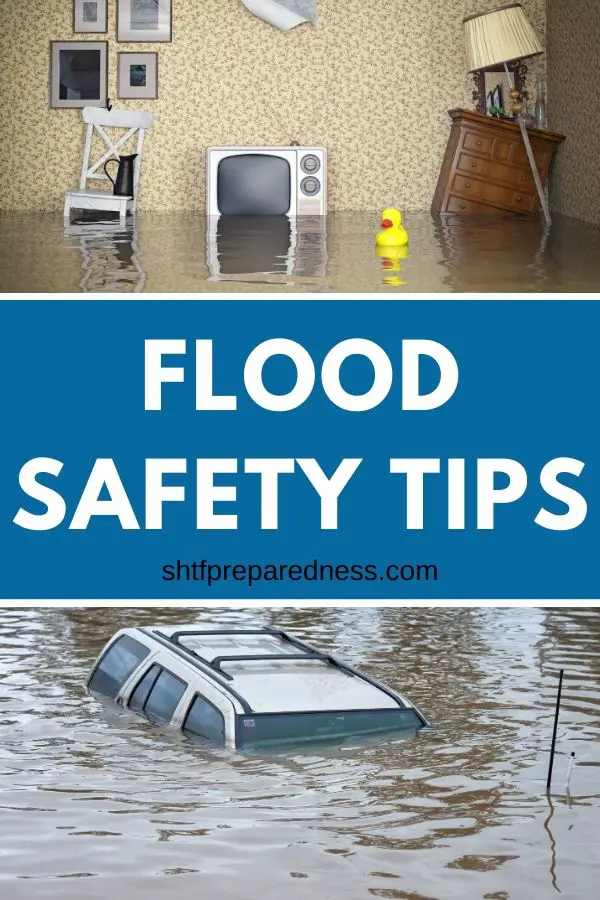SHTFPreparedness may collect a share of sales or other compensation from the links on this page.
Flooding can strike anywhere and, as the name “flash flood” implies, at any time.
When a natural disaster strikes, there are a lot of things you have no control over, like the trees that fall outside your home, the power going out unexpectedly, or finding safety during 85 miles per hour (mph) wind.
As a result, there are some flood safety tips you should remember.

There aren’t many places in the United States that are immune to flooding, so if you think you don’t live or work in one of these locations, you’re probably mistaken.
After all, flooding is the most common natural disaster in the country. From rivers overflowing their bounds to rain cascading down a parched hillside, and even broken water mains, there are many causes of floods.
People who are in near proximity to rivers and main water lines have a higher chance of experiencing flooding than those who live in more central areas.
When floods do come, you’ll want to have your preparations done well in advance. So how can you protect yourself and your home from flooding? Let’s explore some options.
Protect Yourself From Floods With These Flood Safety Tips
Clean Gutters and/or Drains
 Since gutters and drains around the house are designed to transport rainwater and melting the snow away from your home, cleaning them is important.
Since gutters and drains around the house are designed to transport rainwater and melting the snow away from your home, cleaning them is important.
If your gutters aren’t clear or debris for whatever reason, that can cause overflowing and bring unwanted water too close to home. If there’s enough of that spill, it can start seeping through the walls and into your home.
The outside of the gutters is also a likely area that can acquire stains over the course of time.
The same thing goes with drains. Drains blocked by dirt, leaves, and other objects will block the water from escaping. So the water is more likely to flow into your home.
During heavy rains, you should always check those drains in your neighborhood, just to make sure they’re clear.
Assemble an Emergency Supply Kit
Put together an emergency preparedness kit that includes basic necessities.
A good kit should have enough food and water for everyone for at least three to four days. Pack at least three gallons of water per person so everyone can drink a gallon a day.
You should also bring a week’s worth of any special medication, ointments, and/or dietary food your family needs along with a first aid kit.
Pack at least one change of clothes for each person. Include warm clothing and rain-resistant gear.
- Remember to check your food supplies every year, and replace expiring, or contaminated food items.
- Bring personal identification documents such as birth certificates, driver’s licenses, passports, and bank account information. Also, pack some extra cash. Store these in a water container or safe.
- Think of what you and your family will need to complete your kit. You may include items like baby supplies, a can opener, strong duct tape, pet supplies, and sanitary items.
Know Your Threat Level
Believe it or not, not all homes are created equal. Some homes are built on floodplains, while others are built far away from rivers or other water sources. Some are built on hills, and others at their base.
Regardless of where you live, there’s always a threat of flooding. If you know the risk of flooding in your neighborhood, you can be well prepared. And you’ll know how much flood insurance you should get.
Get Flood Insurance
Speaking of flood insurance, while not technically a way to protect your home from flood damage, it is a way to protect your family from covering the full cost of such destruction.
Most people don’t think they’re at risk for flooding in their area and only consider flood insurance when it’s too late.
While you’ll still have to pay deductibles, it’s a lot better than having to pay the bill for everything damaged. Make sure you understand what’s being covered by your insurance: not all flooding is covered in your policy.
For instance, Floodsmart tells clients that floods caused by sewer backups are only covered by insurance if the backup was caused by a flood itself. Otherwise, your insurance company will tell you, “No deal.”
So, make sure you know what insurance policy you’re getting. Also – and this is important – most flood insurance becomes active after 30 days of purchase.
That means if you think your area is expecting heavy rain soon, getting flood insurance a week earlier likely won’t help your situation.
Be sure to keep a catalog of all your belongings — pictures, videos, spreadsheet, and whatever else works for you — so you know exactly what to tell your insurance agent.
Extra Roof Protection
Why do we have a roof, to begin with? Well, it’s to keep out the rain and bad weather that happen all around you. So why, then, would you not try to keep your roof in tip-top shape?
Bad roofing can cause rain and melting snow to leak through your roof into your home, causing damage. If you have an attic, you may not even realize your roof is leaking until it’s too late and the damage is already done.
The next time you repair your roof, consider installing rubber underlayment, which will help waterproof your roof.
We certainly don’t know to stop them, but we can help reduce the dimension of devastation in various ways and avert much loss of lives. Each year, floods sweep away thousands of buildings and precious items. With proper planning, however, your homestead doesn’t have to be part of that tide of loss.
